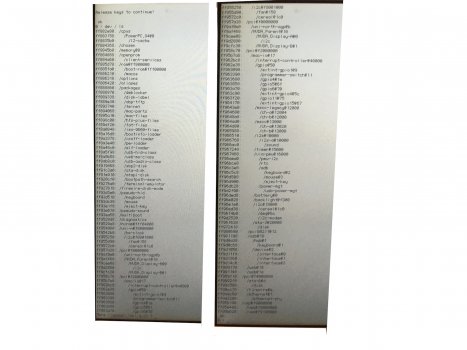I've been installing a bunch of operating systems on my PowerBook G4 12" 1.33GHz (PowerBook6,4) lately. For [reasons] I only wanted to install said operating systems using the built-in USB2 ports — I did not want to use the DVD drive. I have experienced many, many hours of frustrating failures along the way. Eventually I realised that some USB Flash drives simply don't play nice with the PowerBook G4 12". Specifically, they aren't recognised by Open Firmware and thus are not made available as a boot device so that you can boot from them and then install an operating system onto the internal drive.
To possibly save you some time and grief, here is what worked for me, and what didn't...
Note: When testing for compatibility with Mac OS X, all USB Flash drives had an Apple Partition Map (APM) applied, with a single partition formatted to HFS+ (Journaled), which then had the installer image 'restored' to it.
The following drives were recognised by Open Firmware (i.e. the
Although it may be possible to somehow boot from a drive that isn't automatically detected by Open Firmware, drives are cheap and plentiful. I'd rather use a drive that "just works" than spend time entering fiddly commands in Open Firmware.
Even if your PowerBook G4 12" and USB Flash drive play nicely together, there is something else to be aware of: Some operating system installers simply do not work properly when run from USB.
All attempts to perform 'standard' installs of the following operating systems failed:
HTH.
PS: One final (non-USB) boot gotcha for you... I'm not sure if all PowerBook G4 12" laptops have the same "SuperDrive", but mine has a Matshita UJ-825. This is actually a DVD-RW. It's not a DVD+RW or DVD±RW. So if you burn your installer image onto a DVD+R disk using a different machine, transfer it to your PowerBook G4 12", and then try boot from it, all you will get is a few seconds of grindy-grindy noises before the attempt fails and the DVD gets ejected.
To possibly save you some time and grief, here is what worked for me, and what didn't...
Note: When testing for compatibility with Mac OS X, all USB Flash drives had an Apple Partition Map (APM) applied, with a single partition formatted to HFS+ (Journaled), which then had the installer image 'restored' to it.
The following drives were recognised by Open Firmware (i.e. the
dev / ls command yielded a /usb@1b entry followed by a /disk@1 entry):- 2GB USB2 SanDisk Cruzer Colors+ (x1)
- 2GB USB2 Verbatim Store’n’Go (x1)
- 8GB USB2 Corsair Flash Voyager (x1)
- The only drive that performed flawlessly with Mac OS X Tiger and Leopard. No imaging issues. No booting issues. No installation issues. No need to do anything in Open Firmware whatsoever. The only drive that "just worked" for Mac OS X.
- 8GB USB2 Verbatim Store’n’Go Micro (x1)
- 8GB USB2 Verbatim Store’n’Go PinStripe (x4)
- 16GB USB3 Patriot Spark (x1)
- 8GB USB2 SanDisk Cruzer Facet (x2)
- 16GB USB3 Verbatim Store’n’Go Gold (x2)
Although it may be possible to somehow boot from a drive that isn't automatically detected by Open Firmware, drives are cheap and plentiful. I'd rather use a drive that "just works" than spend time entering fiddly commands in Open Firmware.
Even if your PowerBook G4 12" and USB Flash drive play nicely together, there is something else to be aware of: Some operating system installers simply do not work properly when run from USB.
All attempts to perform 'standard' installs of the following operating systems failed:
- Mac OS X 10.3.7 Panther (from a compatible restore disk image)
- you end up with a 'prohibited' sign
- Mac OS X 10.4 Tiger (from a retail disk image)
- not a boot option; you can extract the reason — "[USBdrive] is not bootable because it has no Open Firmware path" — by booting from an installer on a different (e.g. internal disk) partition and then checking the installer log
- Mac OS X 10.4.6 Tiger (from a retail disk image)
- Mac OS X 10.5.4 Leopard (from a retail disk image)
- Mac OS X 10.5.4 Leopard (single-layer DVD version; 4.7GB image)
- you need to customise the install and omit language translations and additional printer drivers, or an error occurs — this is to be expected as those files (plus Xcode) were what was removed from the full retail disk image to bring it down to a size that could fit on a single-layer DVD
HTH.
PS: One final (non-USB) boot gotcha for you... I'm not sure if all PowerBook G4 12" laptops have the same "SuperDrive", but mine has a Matshita UJ-825. This is actually a DVD-RW. It's not a DVD+RW or DVD±RW. So if you burn your installer image onto a DVD+R disk using a different machine, transfer it to your PowerBook G4 12", and then try boot from it, all you will get is a few seconds of grindy-grindy noises before the attempt fails and the DVD gets ejected.
Last edited:


